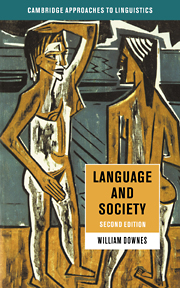Book contents
- Frontmatter
- Contents
- Acknowledgements
- 1 Linguistics and sociolinguistics
- 2 A tapestry in space and time
- 3 Language varieties: processes and problems
- 4 Discovering the structure in variation
- 5 Rhoticity
- 6 At the intersection of social factors
- 7 Change, meaning and acts of identity
- 8 The discourse of social life
- 9 Communication: words and world
- 10 Action and critique
- 11 Language and social explanation
- Further reading
- References
- Index
1 - Linguistics and sociolinguistics
Published online by Cambridge University Press: 05 June 2012
- Frontmatter
- Contents
- Acknowledgements
- 1 Linguistics and sociolinguistics
- 2 A tapestry in space and time
- 3 Language varieties: processes and problems
- 4 Discovering the structure in variation
- 5 Rhoticity
- 6 At the intersection of social factors
- 7 Change, meaning and acts of identity
- 8 The discourse of social life
- 9 Communication: words and world
- 10 Action and critique
- 11 Language and social explanation
- Further reading
- References
- Index
Summary
It is difficult to see adequately the functions of language, because it is so deeply rooted in the whole of human behaviour that it may be suspected that there is little in the functional side of our conscious behaviour in which language does not play its part.
Sapir (1933)Language is a complicated business. In everyday talk, we use the word ‘language’ in many different ways. It isn't clear how ‘language’ should be defined or what the person on the street thinks it actually is! We talk about how miraculously a child's ‘language’ is developing but how they make charming ‘grammar mistakes’, like me maden that instead of ‘I made that’. Here, language is an ability that is blossoming in the child.
But the word is used in a myriad of different ways. For example, people have strong views about how beautiful or how hideous the ‘language’ is of some region or country or age group; how it sounds to the ear. People say ‘I just adore Italian or an Irish accent.’ They grimace or smile at teenager talk on television. Here ‘language’ is being judged aesthetically. By contrast, we remark that you can't really appreciate a culture without knowing the ‘language’, as when we learn French or Japanese for that reason. Then pupils struggle with rules for tenses like the passé composé and imparfait or have to memorize genders and irregular verb conjugations, matters of grammar which seem a million miles from cuisine, film, high tech or Zen Buddhism.
- Type
- Chapter
- Information
- Language and Society , pp. 1 - 15Publisher: Cambridge University PressPrint publication year: 1998
- 1
- Cited by



